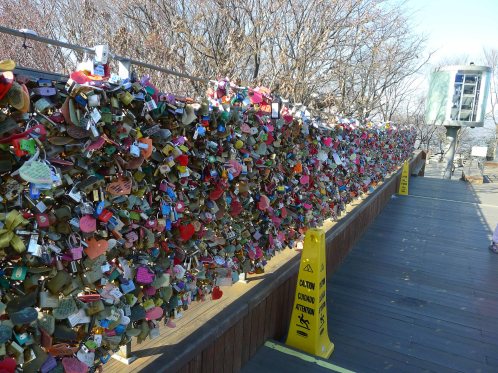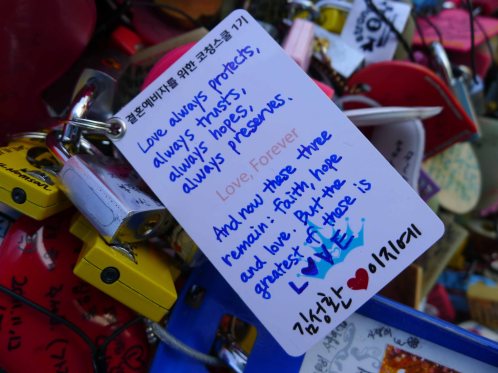Category: photo
Symbolism
The ideograph of a red heart (displayed on Taipei 101) is widely known and recognized all around the world. Even young children learning their letters and shapes are being taught to associate the shape with the word “heart” and “love.” Valentine’s cards, balloons, and even cakes being sold sometimes come in this shape. There are three theories (none of which can be proven to be more valid than the others) of how the heart symbol came about: it was modeled after the human heart; the form and shape of the female body; and following the shape of the Silphium plant seed.
To the curious, the human heart is nowhere close to the shape of a real heart. If you’ve never seen an image of a real heart, this cartoon/drawing version might help:
It’s not quite the same, right? It doesn’t appear to be symmetric, nor does it taper to a sharp point at the bottom, even when looking at it from different angles.But then, there are some people who might argue that the human heart resembles the heart symbol we’ve all been accustomed to. Their interpretation of how the human heart appears to them could be different from how we look at it (in an objective manner, of course).
There are even people who associate the heart symbol with the female torso—the pattern made by the breasts to the genitals (some even say the buttocks). I honestly don’t know what to make of this, but it is just a theory anyway.
The third theory is related to the now-extinct plant seed of silphium, which was traded in the 7th century BC in Cyrene. It was originally used as a seasoning, but it was later used as a form of birth-control. The seedpod of the plant looked a lot like the heart symbol we are familiar with, and this shape was found in the Cyrene coins.
So how did it happen that when we see the ♥ or ♡ shape, we easily remember it to be a representation of a heart? I think we’ll never know, considering even the history of it cannot be traced. Nor would we know how that symbol became popular. I’m guessing the heart symbol only became widely popular after the 1800’s or 1900’s, because people wrote love letters using more of poetic words than graphic symbols.
I believe the usage of the heart symbol has simplified the act of expressing love, even though the symbol has decreased the necessity of articulating what a person really means. When using language, a person has to think of (or try to grasp) the word that best describes their exact feelings. With graphics, one can simply use the heart symbol, but the recipient cannot accurately gauge the extent of the sender’s feelings, just that they know the “love” exists. And I think that’s the complex thing about graphics or symbolism nowadays—it can be interpreted in so many ways. Nevertheless, what really matters is its capability to express ideas and emotions.
References:
The Shape of My Heart
Silphium
Love in Seoul Tower
I’ve actually written one draft post about the symbolism used in relation to love (which I haven’t finished writing due to insufficient research), and then I remembered some of the photos I took while on a family vacation to Seoul, South Korea in December 2011. We had visited N Seoul Tower in Namsan (South Mountain), the tallest point in Seoul. There we saw thousands of locks that hung from the fences, because of the custom that if a couple would lock a padlock together in that public space, their love would be “locked forever.” Well, I didn’t have a lock with me, so I couldn’t try that custom, but I think one of my acquaintances did put a padlock there when she visited with her boyfriend.
Me posing with the “tree” covered with love padlocks.
Apparently, some people also took to vandalizing objects in the area and wrote about their love. Since I can’t read Korean hangul, I have no idea on whether those characters are the names of the people who vandalized the binoculars. Yes, it might seem to be romantic to leave behind “evidence” that you’ve been to a certain place to declare eternal love, but I don’t think it’s appropriate to vandalize public property.
That’s my cousin (she can totally pass as a Korean, right?).
A giant metal heart sculpture. Really I’m surprised how they got that big object to stand on such a small base.
I actually find this love padlock custom interesting, because the couples who visit there are holding on to the hope that their love for their partner will last forever. The padlocks represent exactly just that—hope. The sheer number of padlocks to be seen there attest to the wishes and dreams of people who love (if not romantically, then at least for their family and friends), despite the possibility of losing the people they love.
Observing Love part one
Before I even thought of writing about my own interests, I was already inspired by many people who were doing their own thing, because they had the passion for it. What they do may not make sense to us (if not now, maybe never at all), nor will it be fully appreciated, but sometimes they just don’t care what other people think. They are happy doing/creating something, and that’s what really matters.
I’m pretty sure you’ve met someone like that in your life—perhaps a stranger doing spray art in the street (there’s one like that in Ximending actually), a distant relative, an odd classmate or colleague—maybe you’re even one of them. But I’m not saying that it’s good or bad, I just wish to state the existence of these type of people.
Personally, I respect people who, despite the criticisms they receive from others, have made it a point to stand firm in their beliefs, and approach their craft as something valuable to mankind. I don’t have a specific Top Ten list or anything, but I’d like to mention a few people whom I’ve met (if not physically, at least I’m acquainted with them through social networks) that exhibit passion.
Architect Francisco “Bobby” Mañosa
Arch. Mañosa, a Filipino architect and National Artist, is renown for his love of Filipino culture. His architectural designs definitely mirrors that love, and I really admire him for sticking to that belief. I have had the opportunity to meet the legendary Arch. Mañosa in October 2011, when he toured our board exam review class around his house. I admit to being starstruck by him back then, but I was more impressed by how he showed off about the Filipino culture and lifestyle. And he was definitely successful in representing that through his architecture. He actually advocates the existence and the practice of designing Filipino, even though people would argue otherwise.
Indeed, even I am a little hesitant to claim what exactly is designing Filipino, having no firsthand experience of living in bahay kubo (a small hut usually elevated a few meters from the ground) until I visited a distant relative in the province almost 4 years ago. Yes, I knew the basics of what the traditional Filipino house looked like, but I never knew how the people truly lived. And Arch. Mañosa explained how his design accommodated the traditional Filipino lifestyle.
For example, the house was elevated to almost a full storey high. The kitchen actually faced the main gate, rather than the front door (which was a little to the side), because people in the kitchen would easily see anyone who might ring the doorbell. Also, there were very few doors between every room—the only ones that had an opaque door were the washrooms and the bedrooms. That way, people can conveniently move around the house, and to encourage good air ventilation.
The living room was set in the center of the house, partially enclosed by walls and is illuminated through clerestory windows. Around this living area were several sets of informal tables and chairs, benches. There was no specific dining table in sight—Arch. Mañosa explains that they prefer the freedom to choose wherever they want to sit and eat. They did not need to be confined to one specific table in order to partake of their food.
The building materials used in his house were organic and native; the way he used bamboo is noteworthy and impressive. Decorative elements in his home were diverse, from wooden spoons, shells/conches, to framed photographs. Arch. Mañosa also showed us the playroom and outdoor custom-made bahay kubo of his grandchildren, demonstrating that he doted on the kids. Even the room in which he uses to relax and watch TV has a miniature table and chairs, most likely to accommodate the kids. Truly, the house was family-oriented, even the shed underneath the main floor of the house were filled with lounge chairs and furniture that encourages interaction between people. There’s even a “treehouse” built in one of the big trees in their yard, to allow people to interact with nature as well.
Indeed, despite the growing trend towards modern architecture, Arch. Mañosa has always been committed to designing Filipino. He is confident about and proud of his identity as a Filipino, and is encouraging everyone else in the country to be the same. I do hope that somehow this incredible passion would rub off on me, and I could treat my craft as a way of expressing my ideals, values, and hopes to others.
To Love Reading
I remember getting hooked to reading was when I was in second grade, and I borrowed books from my cousin’s library. Of course, the books were not too intellectual, they were actually kid’s fiction (Sweet Valley Kids), created by Francine Pascal. Every other week I would visit my cousin’s house to borrow the books and return them the next time I visited. When I got older (and when I’ve finished reading all the books my cousins had on Sweet Valley Kids), I moved on to Sweet Valley Twins, then Sweet Valley High (SVH), and eventually Sweet Valley University (SVU).
I started collecting books when I read SVU, scouring the secondhand bookstores for it whenever I can. By the time I got to high school, I began reading+collecting romance novels because of my bookworm friends. One of my high school friends loved reading historical romance novels, and encouraged me to read Judith McNaught’s novels. And another friend gave me a Judith McNaught novel (Once and Always) for my birthday. Since then, I would buy (mostly secondhand, because new copies were expensive) historical romance novels.
Reading historical romance novels has always been enjoyable for me, especially when there are interesting plot twists and interactions between the main characters. And I especially like the 19th century setting, where the British peerage was still very much part of the culture. I can’t exactly pinpoint why I’m so interested in that time period, but it’s fascinating to know that people’s actions and behavior were somewhat influenced by their social status and the Ton’s definition of good manners. But I digress.
In addition to collecting novels, I also began buying a few books related to Architecture when I stepped into college. I admit I haven’t read all the books I bought back in college (even until now), but seeing the books on my shelf, I feel happy. Knowing that I can read and access the books whenever I want, I feel a sense of comfort and relief. Now I don’t need to go to a cousin’s house to borrow books, or visit libraries to check-out books (don’t get me wrong, I love libraries too) when I want to read my favorite books.
When the Internet became popular (I must’ve been in fourth grade then), I learned to surf the web and access websites. Later I found another way of reading stories—online. I got hooked to reading fanfictions (I was so into Japanese animé back then, like Sailormoon) that were uploaded to websites. The technology introduced me to the world of paperless/digital reading, and it allowed me to read fanfictions as long as I had access to a computer and the Internet.
Eventually, electronic books (or e-books) became a widely popular format for reading books. Amazon invented the Kindle, where people can read books displayed using e-ink technology. Although I was only able to get my hands on a 3rd generation Kindle (it was my cousin’s, not mine), I must say that the e-ink technology was brilliant. The text were displayed in a way that looks similar to an actual paperback. I’ve yearned to buy a Kindle, but I finally settled on a Barnes and Noble Nook Color. With the Nook Color, I can read books even at night, just before I go to sleep. Of course, there were many occasions that I slept late because I was too hooked on the story I was reading.
Indeed, the advent of technology allowed me to support my love of reading. Now, possessing a smartphone allows me to read Kindle-version books I’ve bought from Amazon. Portability has become important for me, hence the reason why I buy some books online. But I still do buy hardbound or paperback books occasionally, when I see them in bookstores. Yes, I can be a shopaholic (remember Confessions of a Shopaholic by Sophie Kinsella?), but I find I only have that tendency when it comes to books.
Planting Love
I came across this image in Facebook. It’s a very simple drawing, but this was really interesting for me because of the action being done. While it is not literally/physically possible to intentionally plant love and grow them, I think that there are occasions wherein we unconsciously begin to love someone (like friends, acquaintances, family, etc.) and we can’t pinpoint when that love started. Nor are we able to stop that love from growing, we just know that it just does.






















